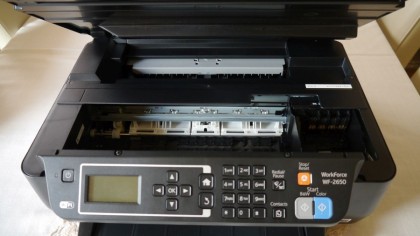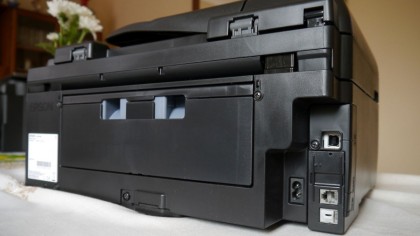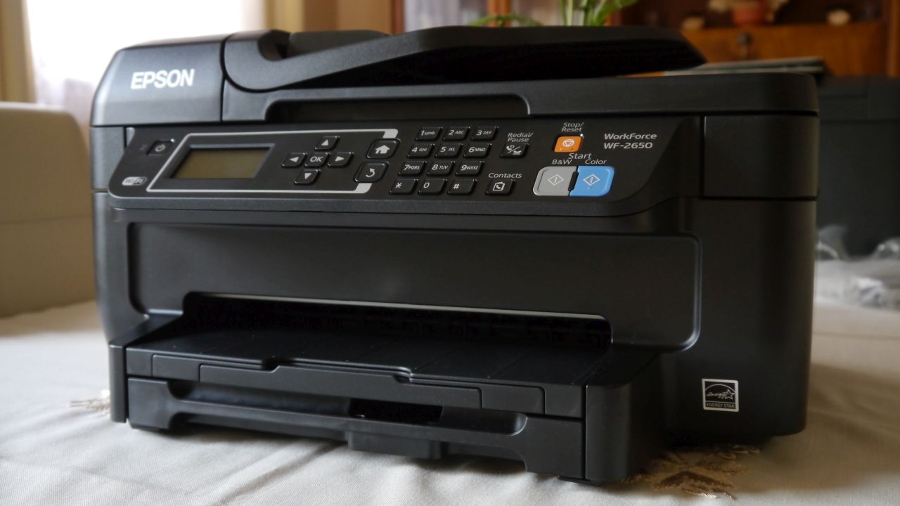Early Verdict
It may boast a cheap price tag, but this seems a very average MFP compared to rivals, and you're likely to be better off going for the model up (Epson's WF-2660).
Pros
- +
Compact MFP
- +
Includes a fax machine
- +
Cheap initial purchase price
Cons
- -
Disappointing print speeds
- -
Very sluggish copying performance
- -
Pricey in terms of running costs
Why you can trust TechRadar
When it comes to printers, there's still a very significant Japanese presence in the market, something that sounds like an oddity given their recent exodus from other tech-related arenas (with moves like Sony giving up on the PC market, and Toshiba ending consumer laptops).
Kyocera Mita, Konica Minolta, Fuji Xerox, Funai, Oki Data, Ricoh, Canon, Brother, Epson and Citizen form the impressive contingent that competes with HP, Lenovo, Dell and now Lexmark (although Funai builds printers for the last two). Of the ten aforementioned companies, Epson is one of the better known firms, having been in the limelight by being a sponsor for the Manchester United football team for nearly six years.
We're reviewing its WorkForce WF-2650 (£69 at Tesco, which is around $100, or AU$140) printer, one of a number of multifunction inkjet printers or AIOs (all-in-ones) that sit in the sub-£100 category and come with features like ADF (automatic document feeder) that make them useful for SMB (small and medium businesses) or home workers.
Perhaps a sign of the maturation in this segment is the fact that this printer was launched in September 2014 and is still part of Epson's product portfolio.
A slower product refresh cycle – as is the case for gaming consoles – means that R&D (research and development) as well as production expenditures can be amortised over a longer period, which translates into lower costs and – hopefully – higher margins for the vendor.

There's also the fact that there wasn't a lot that could be added to these printers back in 2014, and there's not much that can be added even now. The range saw the introduction of Epson's last major new improvement, PrecisionCore, one which the Japanese vendor hailed as the biggest threat to laser printers.
The WF-2650, which competes with the slightly more expensive Canon Maxify MB2050, carries a suggested retail price of £120 (around $175, or AU$245) and packs the printer, a scanner – so with both of these it can be used as a copier – and a fax machine, the latter of which is still popular in Japan.
Sign up to the TechRadar Pro newsletter to get all the top news, opinion, features and guidance your business needs to succeed!
The form factor adopted by the printer is a well-known one – it offers a control panel with a small LCD panel, loads of buttons, along with a movable lid that hides a scanner and hosts the ADF. The printer mechanism is hidden in the printer body and is easily accessible as well by lifting the scanning module.
Anthracite plastic is the usual colour/material for printers and this one is no exception. At 425 x 360 x 230mm, its footprint is a tad larger than an A3 sheet and roughly as high as an A5 one; that's great if you are short on desk space. It weighs less than 7kg as well, which makes it perfect if you want to move the device around.
Its specs are in line with what you'd expect from printers in this price range: 4,800 dpi x 1,200 dpi, a maximum monthly duty cycle of 3,000 pages, duplex printing, separate ink cartridges, up to 33 pages per minute (monochrome), a 2,400 x 1,200 dpi scanner resolution, a 30-page ADF, a 150-sheet paper cassette and a rather flimsy paper tray – be careful with this one.
On top of that you have the usual set of connectivity features: Wi-Fi/Wi-Fi Direct, USB and a phone socket. There's no Ethernet port at this price and certainly no USB cable. Go for its more expensive sibling, the WF-2660, to get the Ethernet port – depending on ongoing promotions, the difference between the two can be as little as £10.
This alternative also offers NFC and a colour touchscreen display so will be a better model to go for if you can get it at a bargain price.
Mobile printing (AirPrint/Cloud Print) and scanning are standard as is scanning to cloud services (Box, Dropbox, Evernote and Google Drive). The controls for the printer, using the arrow keys, are intuitive enough despite the four-line monochrome LCD screen.

When it comes to printing, the WF-2650 printed a 31-page text heavy PDF document in nine minutes and 52 seconds which translates into a print speed of approximately 3.2 pages per minute, a very far cry from its maximum suggested speed. The print test was carried out in simplex mode using Windows drivers and default printer settings.
Quality was decent on 80gsm stock paper with tiny fonts and very thin lines well rendered with barely any noticeable smudges.
Using the copy feature to duplicate the same document (now printed) in monochrome, via the ADF, turned out to be a very tedious task. The WF-2650 took a staggering 19 minutes and 29 seconds to finish the document in its entirety; the printer stopped every now and then for reasons beyond our comprehension. That's a pretty slow 1.6 pages per minute which again is far slower than the time which the box suggested.
Early verdict
We didn't try the software package (Presto/NewSoft's PageManager 9) bundled with this device but we've seen enough to make a judgement. The Workforce WF-2650 is an average multi-function printer especially when faced with the likes of the Canon Maxify MB2050. Its copy speeds were far slower than we expected and the print quality, though good, can't save it from performing quite poorly in terms of an overall perspective.
Consumables don't come cheap either – you can get the whole CMYK high yield pack (16XL) for about £44 (around $65, or AU$90) and high yield for Epson means 500 pages for black and 450 pages for CMY. That translates in a cost per copy that is significantly higher than the competition.
We like the fact that it includes a fax machine and has a small footprint but other than that, you might be better off buying its bigger brother.

Désiré has been musing and writing about technology during a career spanning four decades. He dabbled in website builders and web hosting when DHTML and frames were in vogue and started narrating about the impact of technology on society just before the start of the Y2K hysteria at the turn of the last millennium.
What is a hands on review?
Hands on reviews' are a journalist's first impressions of a piece of kit based on spending some time with it. It may be just a few moments, or a few hours. The important thing is we have been able to play with it ourselves and can give you some sense of what it's like to use, even if it's only an embryonic view. For more information, see TechRadar's Reviews Guarantee.
